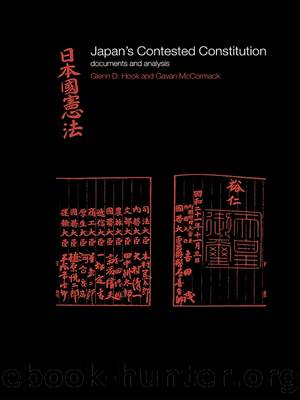Japan's Contested Constitution by Glenn D. Hook Gavan McCormack

Author:Glenn D. Hook, Gavan McCormack [Glenn D. Hook, Gavan McCormack]
Language: eng
Format: epub
Tags: Law, Constitutional, International, Political Science, General
ISBN: 9780415240994
Google: dLrsngEACAAJ
Publisher: Routledge
Published: 2001-01-15T04:15:27+00:00
TOWARD THE IMPLEMENTATION OF ARTICLE 9
Although the âleftâ in post-war Japan adopted the preservation of Article 9 as its raison dâêtre, their explorations of what concretely was meant by preservation of Article 9 did not go very deep.
Domestically, as a result of having renounced armaments and the use of force, little concrete consideration was given to the question of how to advance Japanâs security. Unarmed neutrality may have been one of the possibilities considered, but it was assumed to be unrealistic amid the realities of the Cold War, and subsequent opinion surveys and elections show that the majority of the people did not choose this option. The people firmly rejected constitutional revision, but they accepted the contradictory reality involved in recognition of the existence of the SDF.
Internationally, concrete consideration was not given to how Japan might contribute to the resolution of world conflict. Whatever fears there may have been about being embroiled in another war, little practical consideration was given to how to manifest to the world its peace constitution spirit of âaspiring sincerely to an international peace based on justice and order.â
For this reason, the word âconstitutional defenseâ came to be ridiculed as meaning âone country pacifism.â The main responsibility, however, should attach to governments which, faced with this situation, high-handedly possessed and expanded âwar potentialâ whose possession was clearly forbidden by the constitution, without amending the constitution, merely saying âwe can possess it because it is not war potential.â Not once was the contradiction between constitution and armed forces made clear to the people, and not once were they given the opportunity to choose to resolve it. The people simply gave up thinking deeply about the issue and lapsed into thinking they might as well just enjoy the âpeaceâ they had.
Now that the age of world wars is over, what is required of us, both nationally and internationally, in order to preserve the spirit of the constitution, is the wisdom to implement Article 9. We must put an end to the sterile arguments about what is âconstitutionalâ or ânon-constitutional,â and shift the focus of the debate towards finding a âcreative constitutionalistâ path to breathe life into the spirit of the constitution.
As mentioned earlier, the peace constitution was historically prophetic in character. When considering how to implement it this is a point which should first be recognized. That force is of no use in the settlement of conflict has been demonstrated anew both by the way the Cold War ended and by the course of post-Cold War regional disputes. Unlimited military expansion exhausts economies and comes to threaten security itself. If we look at the examples of the Gulf War and the civil war in Yugoslavia, we should be able to understand that the fundamental causes of conflict cannot be eliminated by force. Although it is still possible to imagine situations where force might be necessary, the spirit of the peace constitution, which rejects force as a means of settling disputes, is not only not âoutdatedâ but is very much in keeping with the times.
Download
This site does not store any files on its server. We only index and link to content provided by other sites. Please contact the content providers to delete copyright contents if any and email us, we'll remove relevant links or contents immediately.
The Secret History by Donna Tartt(18948)
The Social Justice Warrior Handbook by Lisa De Pasquale(12168)
Thirteen Reasons Why by Jay Asher(8847)
This Is How You Lose Her by Junot Diaz(6835)
Weapons of Math Destruction by Cathy O'Neil(6219)
Zero to One by Peter Thiel(5735)
Beartown by Fredrik Backman(5681)
The Myth of the Strong Leader by Archie Brown(5458)
The Fire Next Time by James Baldwin(5385)
How Democracies Die by Steven Levitsky & Daniel Ziblatt(5173)
Promise Me, Dad by Joe Biden(5113)
Stone's Rules by Roger Stone(5052)
A Higher Loyalty: Truth, Lies, and Leadership by James Comey(4907)
100 Deadly Skills by Clint Emerson(4882)
Rise and Kill First by Ronen Bergman(4741)
Secrecy World by Jake Bernstein(4701)
The David Icke Guide to the Global Conspiracy (and how to end it) by David Icke(4657)
The Farm by Tom Rob Smith(4466)
The Doomsday Machine by Daniel Ellsberg(4451)
